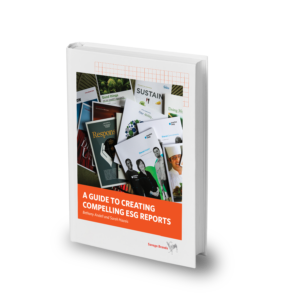Sustainability Reports: Top 10 Mistakes
This article was co-written by Sydney Isaacs & Lisa Pham of Abernathy MacGregor and Bethany Andell of Savage Brands
Sustainability reports have a big task: communicate complex data, tell a story of change, highlight results, and detail goals, commitments and milestones – all while conveying alignment to the company’s core values, staying true to the organization’s purpose and navigating the diverse interests of multiple stakeholders.
As sustainability reporting has expanded, best practices have emerged. So, too, have mistakes that hinder the effectiveness of today’s ESG reports.
Here are the top 10 mistakes that we see in sustainability reports… and how to avoid them.
1 – Limited connection to overall corporate values and strategy
ESG is part of your brand – a representation of who you are, what you stand for and how you are positioned. Companies that exemplify ESG as an integral part of their DNA – from their purpose and values to their overall business and operating strategy – will gain trust instead of cynicism, from the stakeholders that matter most.
2 – Narrow focus on investor audience alone
ESG is not solely an investor issue. Make information and data relevant and understandable to multiple stakeholders including employees, customers, community influencers and suppliers. This can be achieved by bringing data to life with examples and case studies, avoiding industry jargon and acronyms, while defining important terms and explaining what the data means.
3 – Lots of data but no narrative
Context is key. Explain what the data means and why it is important – this will increase its impact and help demystify your business. Through clear narrative, glossaries and data visualization you can show how your data demonstrates progress towards your company’s goals.
4 – Lots of narrative but light on data
Conversely, a thoughtful and carefully worded narrative that offers no relevant data points misses an opportunity to build credibility and articulate progress. Ratings agencies and indexes are using AI (artificial intelligence) and algorithms to find and interpret your data – if the data set they are looking for isn’t there, your company will not be found or included.
5 – Little attention to design and readability
Design should be a strategic tool utilized to create a report that is engaging to read, clear to understand and makes information easy to find. Strategic use of infographics, illustrative or photographic imagery, color, call outs and even white space will help simplify and amplify salient messages. On the other hand, don’t fall into the trap of “form over substance.”
6 – Lack of content accessibility
The launch of your sustainability report is an opportunity to market your company to a number of different constituents. Highlight it on your homepage, issue a press release with a direct link to the report and create a series of social media posts to drive traffic. Take it further by repurposing content for use in other channels, including other areas of your site, your recruiting materials, your investor communications and your sales and marketing.
7 – Missing the power of storytelling
A strong story can quickly convey the meaning behind your data or message. Letting a piece of data speak for itself with no context can lead to misinterpretation and misunderstanding. Case studies or vignettes don’t just liven up your report, they can actually help create clarity, strengthen understanding and increase recall.
8 – Backwards-looking reporting without future-looking, concrete targets
Your sustainability report is an opportunity to lay out goals, describe the steps you are taking to get there and provide transparent progress over time. By connecting the dots between what, when and how, you will build trust and credibility with readers.
9 – Lack of relevance to real-world issues
Your report should emphasize quality over quantity and put forth metrics that have a clear connection to meaningful, relevant issues for your employees, communities and investors. You should avoid disclosure for the sake of disclosure and let metrics drive substantive change.
10 – Limiting ESG to an annual Sustainability report
Discussion of sustainability should be foundational to a company’s message and communications strategy rather than tangential. Find ways to reach multiple stakeholders and integrate ESG goals, messages, metrics and achievements into other communications materials and channels year-round. Incorporate ESG communications into your website, public relations, internal communications, recruiting activities, sales, marketing, proxy statements and ongoing investor communications and social media.
The above mistakes can be viewed as opportunities for improvement in your next Sustainability Report. At the end of the day, a well written and designed sustainability report that takes advantage of today’s communications best practices will ensure you are communicating your message clearly and delivering a content-rich story that is compelling, understandable, memorable and easy to read.
Co-Author: Bethany Andell – Savage Brands helps organizations uncover who they are and what they stand for, and use this foundation to craft compelling brands and engage employees. Align your communications and experiences to your “why” to spark organizational change, drive business outcomes and make a positive impact.
Co-Authors: Sydney Isaacs & Lisa Pham – Abernathy MacGregor is a leading strategic communications advisor particularly in pivotal times of change. The firm specializes in advising CEOs, board directors and senior executives on effective stakeholder communications, engagement and advocacy initiatives in today’s highly complex and interconnected world. Since 1984, Abernathy has provided superior, customized communications strategies and an intensely collaborative and high-energy commitment to its clients.
